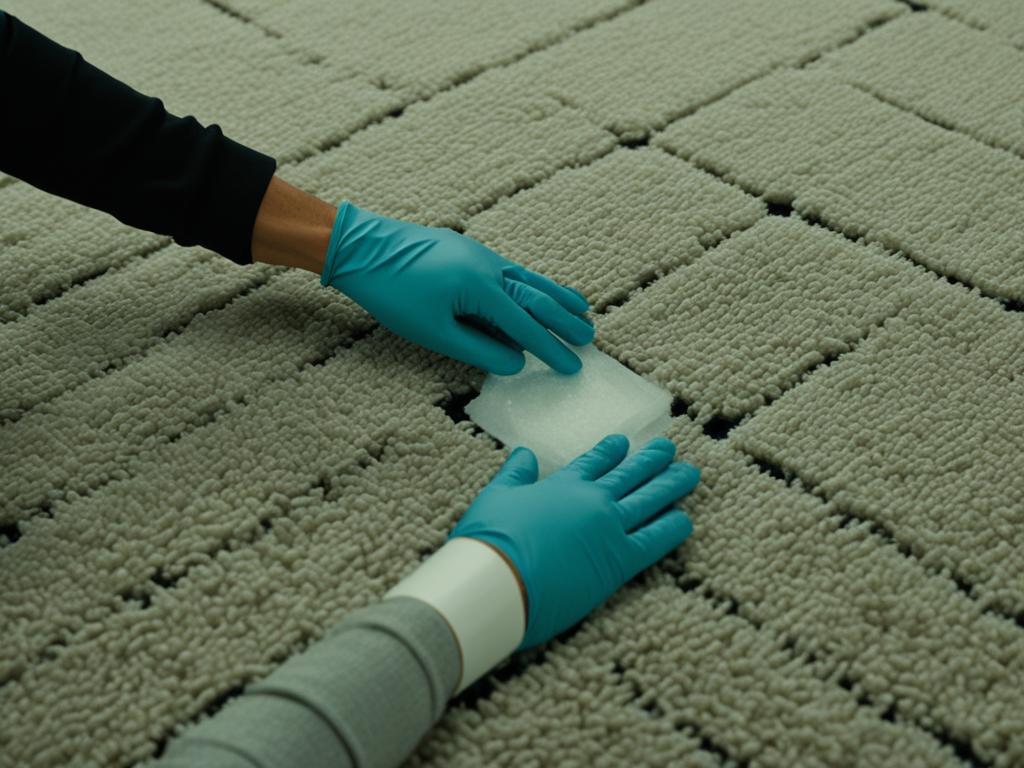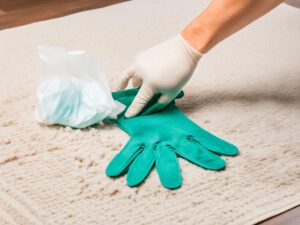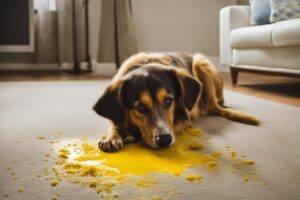Are you struggling to remove sticky tape residue from your carpet? Don’t worry, we’ve got you covered! Removing stubborn adhesive from your carpet can be a daunting task, but with the right methods, it can be done easily. In this article, we will guide you through different techniques to effectively remove sticky tape residue from your carpet, restoring its cleanliness and appearance.
Key Takeaways:
- Removing sticky tape residue from carpet can be challenging, but it can be done easily with the right methods.
- Methods such as vinegar, WD-40, rubbing alcohol, heat, or professional steam cleaning can effectively remove sticky tape residue from your carpet.
- Before applying any cleaning solution, always test it on a small area of the carpet to avoid any potential damage.
- Scraping off excess adhesive and being cautious with heat are important tips to keep in mind during the removal process.
- If all else fails, consider hiring professionals for steam cleaning to ensure effective removal of adhesive residue.
Method 1: Vinegar
If you’re dealing with sticky tape residue on your carpet, vinegar can be an effective solution. Here’s how you can use white vinegar to remove stubborn adhesive:
- Start by removing any excess adhesive by gently dabbing at the spot with a towel. For dried adhesive, use a damp towel to moisten the area and make it easier to remove.
- Pour some distilled white vinegar onto a cloth and begin wiping the affected area. Make sure to thoroughly cover the residue, applying firm but gentle pressure.
- Continue wiping for at least a minute to allow the vinegar to break down the sticky residue.
- After wiping, let the vinegar sit on the spot for at least 15 minutes. This will give it more time to penetrate the adhesive and make it easier to remove.
- Once the vinegar has had time to work its magic, use a wet cloth to remove any remaining adhesive. Gently scrub the area to lift off the residue.
- Finally, allow the carpet to dry completely before walking on it or placing any furniture back on it.
Using vinegar can be a safe and natural way to tackle sticky tape residue on your carpet. However, it’s always a good idea to test any cleaning solution on a small, inconspicuous area of the carpet before applying it to a larger area.
| Vinegar Method: | Pros: | Cons: |
|---|---|---|
| Effective in breaking down adhesive | Natural and safe to use | May require multiple applications for stubborn residue |
| No harsh chemicals | Readily available and affordable | Strong vinegar smell during application |
Method 2: WD-40
To remove sticky tape residue from your carpet, try using WD-40. Here’s how:
- Start by scraping the carpet with a plastic knife or paint scraper to remove as much tape as possible.
- Dab WD-40 onto the remaining adhesive and let it set for 15 minutes.
- Scrape the carpet again to remove as much adhesive as possible.
- Finally, apply a carpet cleaner, such as Goo Gone, to finish the clean-up.
Using WD-40 can effectively dissolve sticky tape residue and make it easier to remove from your carpet. Just be sure to test a small, inconspicuous area of the carpet with WD-40 first to ensure it doesn’t cause any damage.
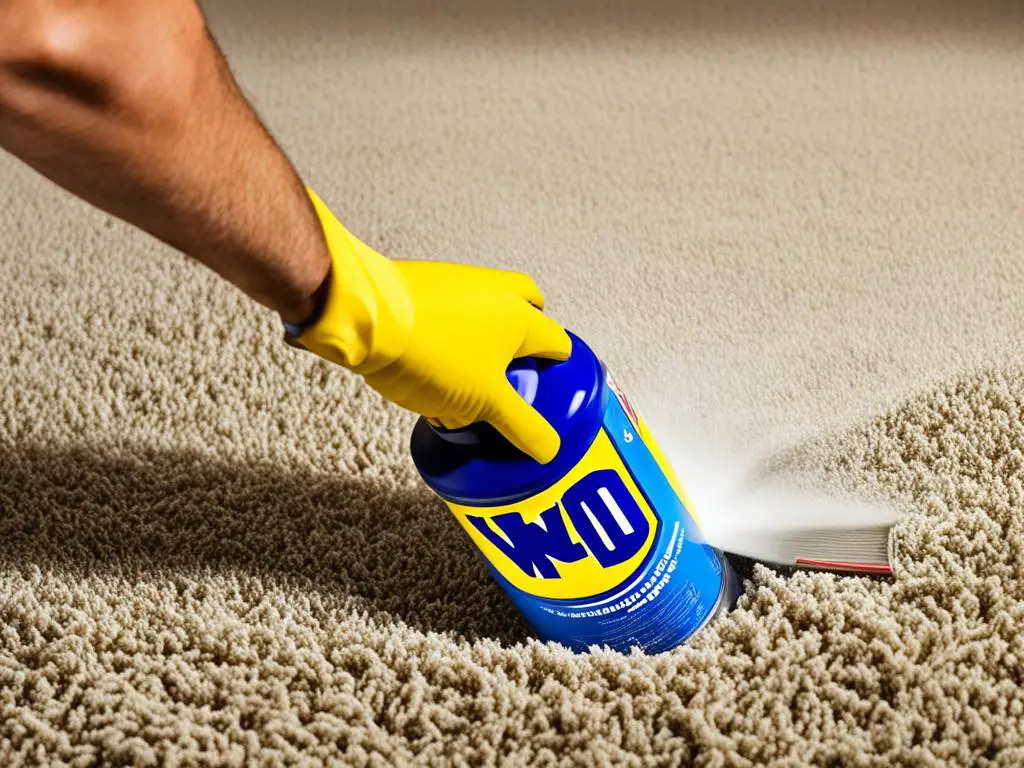
By following these simple steps, you can say goodbye to sticky tape residue on your carpet and keep it looking clean and pristine.
Method 3: Rubbing Alcohol
When it comes to removing stubborn adhesive tape residue from your carpet, rubbing alcohol can be a highly effective solution. Its strong solvent properties help break down the stickiness, making it easier to remove. Here’s how you can use rubbing alcohol to get rid of sticky tape residue from your carpet:
- Dampen a clean cloth or paper towel with rubbing alcohol.
- Press the cloth or towel onto the adhesive residue, applying gentle pressure.
- Rub the cloth or towel back and forth over the residue, using small circular motions.
- Continue rubbing until the adhesive starts to loosen and come off the carpet fibers.
If the adhesive is particularly stubborn, you can take an extra step to enhance the effectiveness of rubbing alcohol. Soak a cloth in rubbing alcohol and place it over the spot with the adhesive residue. Leave it there for about 10-15 minutes, allowing the rubbing alcohol to penetrate the residue. Afterward, remove the cloth and proceed with rubbing to remove the adhesive completely.
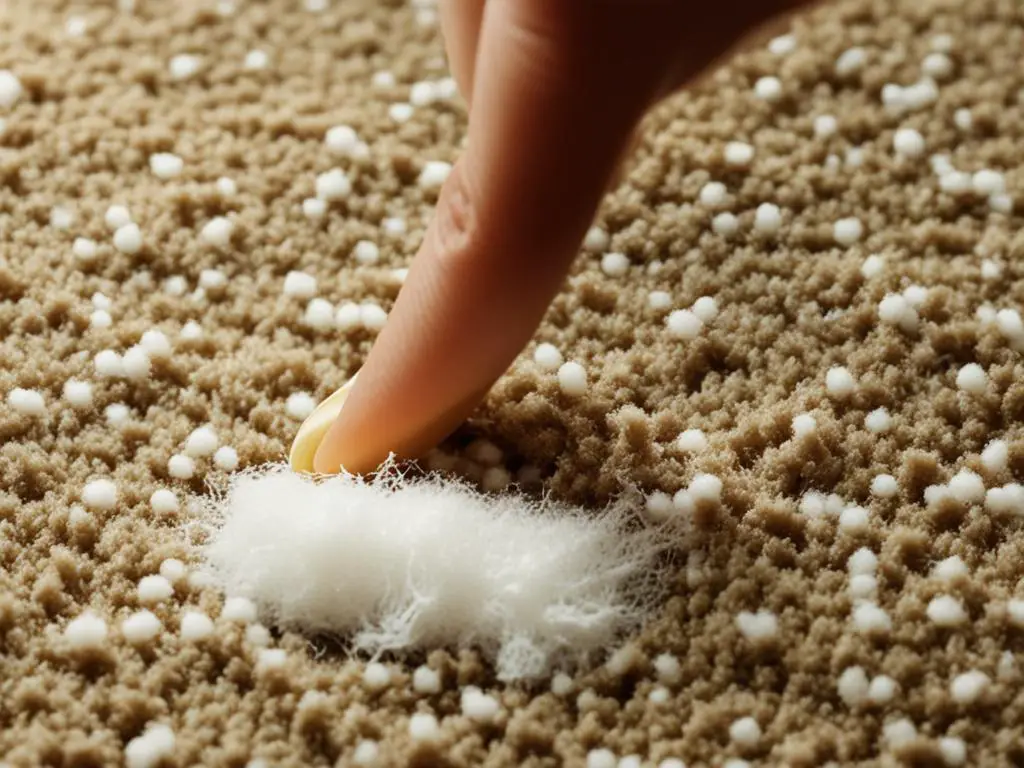
Method 4: Heat
To remove sticky tape residue from carpet using heat, you can utilize a simple household tool – an iron. Here’s how:
- Plug in the iron and set it to the highest steam setting.
- Place a paper towel over the spot where the residue is located.
- Use a clean cloth to cover the paper towel.
- Once the iron has reached the proper temperature, gently press it over the cloth for approximately 10 seconds.
As the heat and steam permeate the adhesive, it should transfer to the paper towel, effectively removing the sticky residue from your carpet. Be cautious not to press the iron too firmly, as excessive heat could potentially damage the carpet fibers.
If you’re unsure about using the iron directly on your carpet, you can test this method on a small, inconspicuous area first to ensure it doesn’t cause any adverse effects.
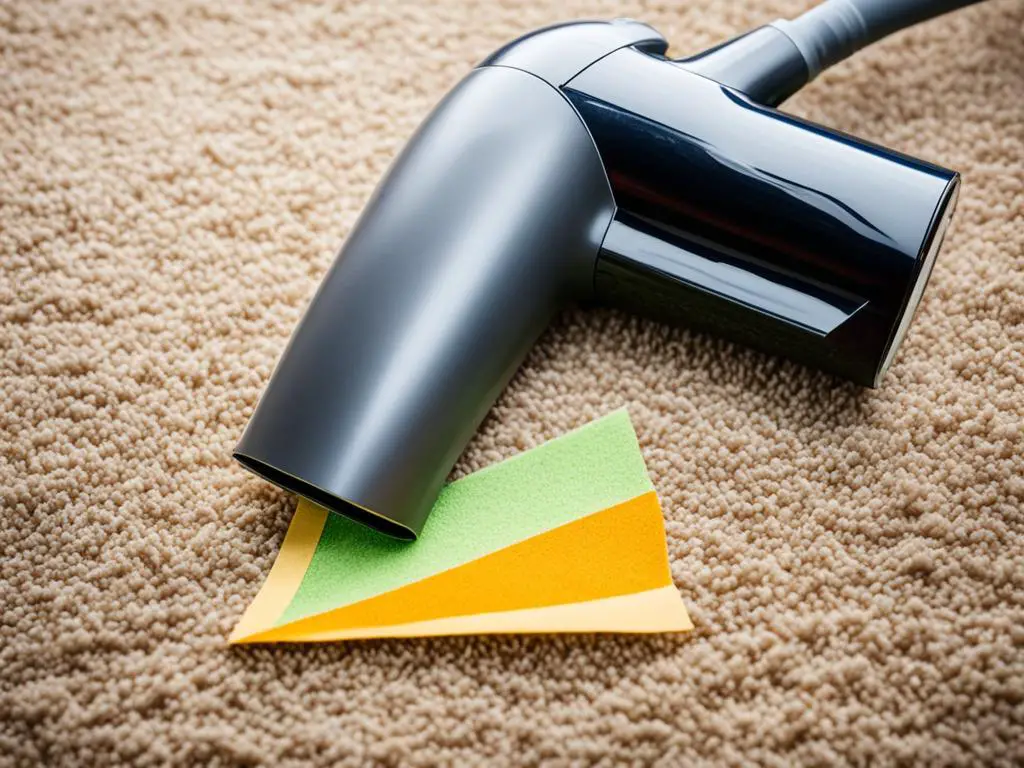
Method 5: Professional Steam Cleaning
If all else fails, it may be necessary to hire professionals for steam cleaning. They have the knowledge and experience to effectively remove adhesive residue from carpets. Make sure to inquire about the type of cleaning solution they will use, and if you prefer environmentally safe options.
Steam cleaning is a popular method for carpet tape residue removal because it combines the power of high-temperature steam with professional-grade equipment. The steam helps loosen and dissolve the sticky residue, while the extraction process removes it from the carpet fibers.
Professional steam cleaning offers several advantages:
- Deep Cleaning: Steam cleaning penetrates deep into the carpet fibers, reaching the stubborn adhesive residue that may not be accessible with other methods.
- Efficiency: Professional-grade equipment ensures thorough and efficient cleaning, saving you time and effort.
- Safety: Steam cleaning is a safe and non-toxic method, making it suitable for households with children and pets.
- Prevention: Hiring professionals for carpet cleaning can help prevent future tape residue buildup and prolong the lifespan of your carpet.
If you decide to hire professionals, it’s important to choose a reputable company. Look for certifications, customer reviews, and ask for recommendations from friends or family. Additionally, inquire about the cost, scheduling, and any warranties or guarantees offered.
Remember that professional steam cleaning typically requires some preparation. Clearing the area of furniture and ensuring proper ventilation can help facilitate the cleaning process.
Consider professional steam cleaning as a reliable option when all other methods have failed. The expertise and specialized equipment of professionals can provide you with a hassle-free and effective solution for removing sticky tape residue from your carpet.
Additional Tips
When it comes to removing sticky tape residue from your carpet, it’s essential to keep these helpful tips in mind:
1. Test Cleaning Solutions
Before using any cleaning solution on a larger area of your carpet, it’s crucial to perform a patch test on a small, inconspicuous area first. This will help ensure that the cleaning solution doesn’t cause any discoloration or damage to your carpet fibers.
2. Scrape Off Excess Adhesive
One of the first steps in removing sticky tape residue is to scrape off as much of the adhesive as possible. Use a plastic knife or paint scraper to gently lift and remove any excess tape before applying any cleaning solution. This will make the cleaning process more effective.
3. Caution with Heat
If you’re using heat as a method to remove sticky tape residue, be cautious to avoid damaging the carpet fibers. Always follow the manufacturer’s instructions for any heat-based method and ensure that you don’t overheat the carpet, as it can lead to discoloration or even melt the carpet fibers.
| Tip | Description |
|---|---|
| 1 | Test cleaning solutions on a small area |
| 2 | Scrape off excess adhesive |
| 3 | Use heat with caution |
By following these additional tips, you can achieve successful sticky tape residue removal and restore the pristine look of your carpet.
Conclusion
In conclusion, there are several effective methods for removing sticky tape residue from carpet. Whether you choose to use vinegar, WD-40, rubbing alcohol, heat, or opt for professional steam cleaning, each method offers its own benefits and can be successful in restoring the cleanliness of your carpet.
It is important to carefully assess your situation and select the appropriate method for your specific needs. Remember to always test any cleaning solution on a small, inconspicuous area of the carpet before applying it to the entire surface. This will help you avoid any potential damage or discoloration.
With the right approach and proper techniques, you can easily eliminate sticky tape residue and enjoy a clean and fresh carpet once again. Choose the method that works best for you and say goodbye to those stubborn adhesive marks!
FAQ
How can I remove sticky tape residue from carpet?
There are several methods you can try to remove sticky tape residue from carpet. Some options include using vinegar, WD-40, rubbing alcohol, heat, or professional steam cleaning.
How do I use vinegar to remove sticky tape residue from carpet?
To use vinegar, pour distilled white vinegar onto a cloth and wipe the affected area for at least a minute. Leave the vinegar on the spot for at least 15 minutes, then use a wet cloth to remove any adhesive and let the area dry.
Can I use WD-40 to remove sticky tape residue from carpet?
Yes, WD-40 can be effective for removing sticky tape residue from carpet. Start by scraping off as much tape as possible, then dab WD-40 onto the remaining adhesive and let it set for 15 minutes. Scrape the carpet again to remove as much adhesive as possible, and finish by applying a carpet cleaner.
How can rubbing alcohol help remove adhesive tape residue from carpet?
Dampen a clean cloth or paper towel with rubbing alcohol and press it into the carpet. Rub slightly to remove the adhesive residue. For stubborn adhesive, you can lay an alcohol-soaked cloth over the spot for about 10-15 minutes before rubbing.
Is heat an effective method for removing sticky tape residue from carpet?
Yes, heat can be used to remove sticky tape residue from carpet. Plug in an iron and set it to the highest steam setting. Place a paper towel over the spot and use a clean cloth to cover it. Once the iron has reached the proper temperature, iron over the cloth for approximately 10 seconds. The adhesive should transfer to the paper towel.
Should I consider professional steam cleaning for removing sticky tape residue from carpet?
If other methods have failed, it may be necessary to hire professionals for steam cleaning. They have the knowledge and experience to effectively remove adhesive residue from carpets. Make sure to inquire about the type of cleaning solution they will use and if you prefer environmentally safe options.
Do you have any additional tips for removing sticky tape residue from carpet?
Yes, it’s important to test any cleaning solution on a small, inconspicuous area of the carpet before using it on a larger area. Scrape off as much of the adhesive as possible before applying any cleaning solution. Be cautious with heat to avoid damaging the carpet fibers.
What is the best way to remove sticky tape residue from carpet?
The best way to remove sticky tape residue from carpet will depend on the specific situation. Try using vinegar, WD-40, rubbing alcohol, heat, or professional steam cleaning. Test a small area before applying any cleaning solution and follow the appropriate method for your situation.
